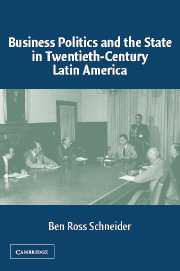Book contents
- Frontmatter
- Contents
- List of Tables
- List of Abbreviations
- Acknowledgments
- PART I INTRODUCTION AND ARGUMENTS
- PART II CASES AND COMPARISONS
- 3 From State to Societal Corporatism in Mexico
- 4 From Corporatism to Reorganized Disarticulation in Brazil
- 5 Business in Colombia: Well Organized and Well Connected
- 6 Consultation and Contention in the Making of Cooperative Capitalism in Chile
- 7 Business Politics in Argentina: Fragmented and Politicized
- PART III IMPLICATIONS AND CONCLUSIONS
- Appendix A Background Information on Major Business Associations
- Appendix B Interviews
- Appendix C Conversions
- References
- Index
4 - From Corporatism to Reorganized Disarticulation in Brazil
Published online by Cambridge University Press: 23 November 2009
- Frontmatter
- Contents
- List of Tables
- List of Abbreviations
- Acknowledgments
- PART I INTRODUCTION AND ARGUMENTS
- PART II CASES AND COMPARISONS
- 3 From State to Societal Corporatism in Mexico
- 4 From Corporatism to Reorganized Disarticulation in Brazil
- 5 Business in Colombia: Well Organized and Well Connected
- 6 Consultation and Contention in the Making of Cooperative Capitalism in Chile
- 7 Business Politics in Argentina: Fragmented and Politicized
- PART III IMPLICATIONS AND CONCLUSIONS
- Appendix A Background Information on Major Business Associations
- Appendix B Interviews
- Appendix C Conversions
- References
- Index
Summary
The presumption that one will not be heard discourages by itself interest in participating, given the skepticism in the efficacy of this participation. The certainty of the futility of action precludes the participation of many industrialists who, otherwise, would be active.
Brazilian industrialist, 1976Introduction
An examination of business associations in Brazil raises several major questions. Why were some of the wealthiest and best-staffed associations in Latin America so poorly equipped to represent business? Comparatively, why were encompassing associations so much weaker in Brazil than in other countries of the region? And why did some of the most powerful industrial associations in the region in the 1940s and 1950s degenerate over time into much weaker and politically marginal organizations? On the first question, appearances in Brazil were deceptive. On paper, Brazilian associations organized nearly all of business, had massive resources that they spent on sophisticated research and coordinating departments, and appeared regularly in the press to air business's views on the issues of the day. Yet, most prominent businesspeople and top government officials readily admit that these impressive-looking associations were in fact weak and unrepresentative, and economic and political elites regularly circumvented them in order to communicate. In his earlier incarnation as one of Brazil's leading sociologists and students of business politics, Fernando Henrique Cardoso concluded that the Brazilian “bourgeoisie never had effective political organization and pressure instruments” (Cardoso 1973, 148).
- Type
- Chapter
- Information
- Publisher: Cambridge University PressPrint publication year: 2004
- 1
- Cited by



